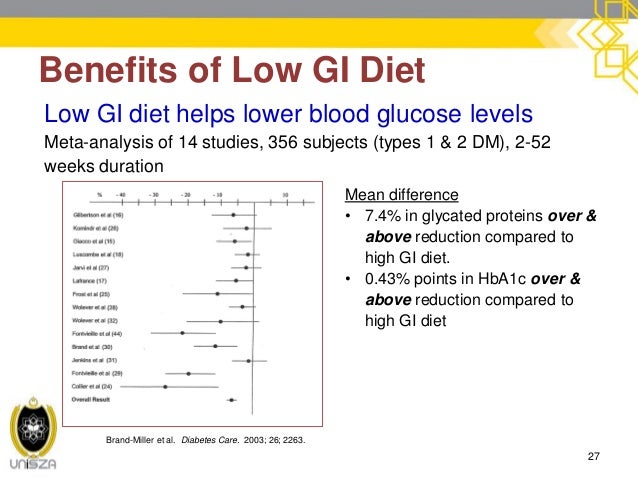
Studies have shown that the low GI diet may result in weight loss reduce blood sugar levels and lower the. The Glycemic Index Gi is a tool that measures how carbohydrates affect blood glucose levels.

The Glycemic Index Foundation suggest that aiming for an average dietary GI score of 45 may offer the most significant health benefits.
What is low glycemic index mean. What is low Gi. The Glycemic Index Gi is a tool that measures how carbohydrates affect blood glucose levels. It then ranks the quality of carbohydrates based on this score.
Carbohydrates are an essential part of our diet since they provide fuel for the brain most other organs and muscles during exercise. However not all carbohydrate foods are equal. What It Is and How to Use It Low glycemic diet.
The low glycemic diet involves swapping out foods with a high GI for those with a lower GI. Glycemic index of foods. Determining the GI of foods that you often eat can be useful if.
A low glycemic diet uses the glycemic index to determine which foods are less likely to impact blood sugar levels significantly. Low or medium GI foods are broken down more slowly and cause a gradual rise in blood sugar levels over time. Some fruit and vegetables.
The Glycemic Index Foundation suggest that aiming for an average dietary GI score of 45 may offer the most significant health benefits. The low glycemic low GI diet is based on the concept of the glycemic index GI. Studies have shown that the low GI diet may result in weight loss reduce blood sugar levels and lower the.
The glycemic index GI is a scale that ranks a carbohydrate-containing food or drink by how much it raises blood sugar levels after it is eaten or drank. Foods with a high GI increase blood sugar higher and faster than foods with a low GI. 4 reasons to eat low GI foods.
Choosing better carbs not only crowds out empty-calorie glucose-raising foods but also helps battle many health threats. Heres what eating more high-fibre low GI foods will do for you. Adapted from Food Cures.
A low-glycemic diet can help you control your weight by minimizing spikes in your blood sugar and insulin levels. This is particularly important if you have type 2 diabetes or at risk of developing it. Low-glycemic diets have also been linked to reduced risks for cancer heart disease and other conditions.
Eight principles of low-glycemic eating. Your guide to finding low GI foods to keep your blood sugar stable Harvard Medical Schools Healthbeat explains that the glycemic index GI of a food is a measure of how a specific food with carbohydrates causes blood sugar to rise. The glycemic load GL is a relatively new way to assess the impact of carbohydrate consumption that takes the glycemic index into account but gives a fuller picture than does glycemic index alone Glycemic index is a value often assigned to carbohydrate foods based on how quickly or slowly they digest and affect the blood sugar.
Carbohydrates with a low GI - usually less 55 or less - are. Foods that are high in glycemic index are those with a number higher than 70 to 100. Foods with a medium glycemic index are those between 50 and 70.
Foods with a low glycemic index are all those types of food below 50. Limitations of GI values. Some foods like ice cream have a low glycemic index because their high-fat content slows digestion which means they dont cause a big spike in blood sugar after theyre eaten.
On the basis of GI alone you might conclude that ice cream was a good thing to include in your low GI diet but its high in calories and fat. Do you know what the glycemic index is. The glycemic index is a measure of how sugary a food is.
Its a scale from zero to 100 where 100 is the glycemic inde. GI numbers are to be used as a guide only as individual foods do not have the same response in all people with diabetes. Low GI foods are foods with a GI less than 55.
Intermediate GI foods are foods with a GI between 55 and 70. High GI foods are foods with a GI greater than 70. Pretzels for example have a glycemic index of 83.
Meanwhile foods with a low GI are digested and absorbed at a slower rate and subsequently cause a slower rise in blood sugar levels. These are typically rich in fiber protein andor fat. Examples of these include apples with a glycemic index of 28 Greek-style yogurt at 11 and peanuts at seven.
Keep in mind that a low GI doesnt mean a food is high. Low-glycemic-load foods tend to be whole unprocessed foodsfresh fruits and veggies whole grains beans and lentilsthe only type of carbs youll find in The Fast Metabolism Diet. You wont find meats and fats on the glycemic index because they dont contain any sugar Dont get too wrapped up in the numbers though.